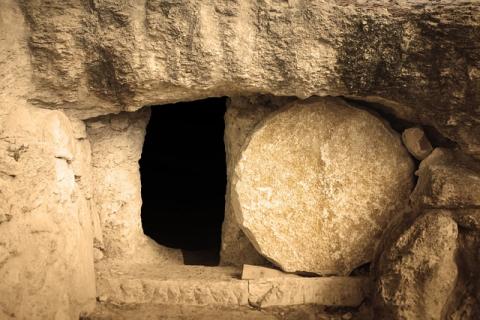Rock Tomb: One Careful Owner. Barely Used.

As I read the scriptures this morning, my eyes lingered on a verse which we tend to skip over. It is Luke 23: 53, and describes Joseph the Arimathean receiving the body of Jesus from the cross, that it might be appropriately buried:
Then he took it down, wrapped it in linen, and laid it in a tomb that was hewn out of the rock, where no one had ever lain before.
Two things struck me: the tomb was from hewn rock and no-one had used it before.
A rock-cut tomb would have been very expensive. Think of the labour, the tools and the planning required to hollow out a rock, as opposed to digging a hole. When God made this rock at creation or the flood, He must have known that one day it would be mined and excavated that the deceased Lord Jesus might lay therein. Is burial in rock significant, or just an ancient preference? It certainly fulfils the prophecy that Messiah’s grave would be ‘with the rich’. There may be a link here to the burial of Israel (Jacob) in Genesis 50: 13:
For his sons carried him to the land of Canaan, and buried him in the cave of the field of Machpelah, before Mamre, which Abraham bought with the field from Ephron the Hittite as property for a burial place.
Jacob was buried in a rock tomb specially purchased by Abraham. Indeed, this was the only piece of land actually owned by the nomadic patriarch (Gen 23:20). This was so he, his wife and their son might have somewhere to lay in perpetuity. The Lord Jesus, in contrast, did not own His own tomb, and to do so would have been a poor investment, for His planned usage was slight. Likewise, His ‘seed’ would not share that tomb with Him, but rather be released from death and the grave.
In Matthew 12:40, Jesus states
For as Jonah was three days and three nights in the belly of the great fish, so will the Son of Man be three days and three nights in the heart of the earth.
A rock tomb is more akin to the great fish that a dug hole. Just as Jonah is spat out of the fish in 2:10, so the tomb could not hold Him. Indeed, it was Christ who spat out death. The rock tomb also better resembles a prison, a holding cell, than some other form of funereal container. The ‘grave’ or ‘sheol’ is likened to an impenetrable prison in scripture:
But God will redeem my soul from the power of sheol (Psalm 49:15);
What man can live and not see death? Can he deliver his soul from the power of sheol? (Psalm 89:48).
Between His death and resurrection, Christ went to death’s great jail where He preached (1 Peter 3:19). That Christ should be entombed and incarcerated is a fitting picture of death- and His resurrection a fitting picture of release and escape, the grim prison walls crumbling before Him. Hosea saw the day and was glad:
“I will ransom them from the power of the grave" (Hosea 13:14).
Secondly, the tomb had never been used before. It was a fresh commission. Tombs were often communal, with ‘shelves’ for various family members. With time’s passage, enterprising folk might spring-clean old tombs, the denizens of which were long forgotten. The old bones would be removed so a new family might commandeer the space. This is not unlike an old English churchyard, in which plots are re-used as former burials decompose and become part of the soil. Grave diggers are not unused to encountering the odd bone or coffin nail as they dig new cavities. The tomb of Jesus, however, was fresh and untouched. Joseph was a rich man and could afford his own vault, not having to recycle those of others’. Is this more significant than a fulfilment of Isaiah’s rich man prophecy?
In 2 Kings 13:21, we read that Moabites
…put the [dead] man in the tomb of Elisha; and when the man was let down and touched the bones of Elisha, he revived and stood on his feet.
Christ was sometimes associated with Elisha and Elijah. To discount any foolish explanations regarding Christ’s body rising on account of it having touched the tomb’s other occupants, God determined there wouldn’t be any. Christ rose by the power of the Spirit of God (Romans 8:10), not by exposure to the remains of others.
By Christ’s resurrection from His rock-cut tomb, never before used, we too shall rise and leave behind our urns and plots. Contrast the believer with those alive at Christ’s return, who desire to flee to caves and rocks rather than face His judgement:
And the kings of the earth, the great men, the rich men, the commanders, the mighty men, every slave and every free man, hid themselves in the caves and in the rocks of the mountains.
-Revelation 6:15
The resurrection is not just about having life after death- we get that anyway. It’s about no longer fearing the judgement we deserve. Although Joseph’s tomb had not previously been occupied, it was probably used afterwards, if not by Joseph, then by later generations, for whom the Jesus affair meant little. Let the dead bury their dead, but let the sleeper rise from the dead, and Christ will shine on him!
Image by Ben Burton from Pixabay
- Log in to post comments


 Sunday Worship 10.45am & 6.00pm
Sunday Worship 10.45am & 6.00pm